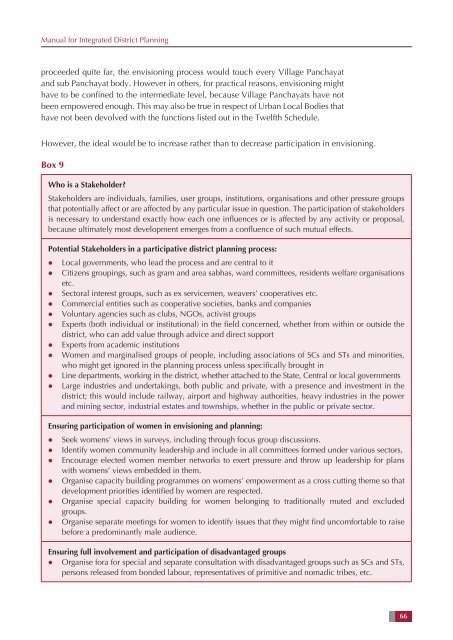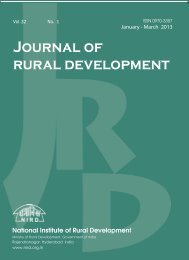Manual for Integrated District Planning - National Institute of Rural ...
Manual for Integrated District Planning - National Institute of Rural ...
Manual for Integrated District Planning - National Institute of Rural ...
You also want an ePaper? Increase the reach of your titles
YUMPU automatically turns print PDFs into web optimized ePapers that Google loves.
<strong>Manual</strong> <strong>for</strong> <strong>Integrated</strong> <strong>District</strong> <strong>Planning</strong><br />
proceeded quite far, the envisioning process would touch every Village Panchayat<br />
and sub Panchayat body. However in others, <strong>for</strong> practical reasons, envisioning might<br />
have to be confined to the intermediate level, because Village Panchayats have not<br />
been empowered enough. This may also be true in respect <strong>of</strong> Urban Local Bodies that<br />
have not been devolved with the functions listed out in the Twelfth Schedule.<br />
However, the ideal would be to increase rather than to decrease participation in envisioning.<br />
Box 9<br />
Who is a Stakeholder?<br />
Stakeholders are individuals, families, user groups, institutions, organisations and other pressure groups<br />
that potentially affect or are affected by any particular issue in question. The participation <strong>of</strong> stakeholders<br />
is necessary to understand exactly how each one influences or is affected by any activity or proposal,<br />
because ultimately most development emerges from a confluence <strong>of</strong> such mutual effects.<br />
Potential Stakeholders in a participative district planning process:<br />
• Local governments, who lead the process and are central to it<br />
• Citizens groupings, such as gram and area sabhas, ward committees, residents welfare organisations<br />
etc.<br />
• Sectoral interest groups, such as ex servicemen, weavers’ cooperatives etc.<br />
• Commercial entities such as cooperative societies, banks and companies<br />
• Voluntary agencies such as clubs, NGOs, activist groups<br />
• Experts (both individual or institutional) in the field concerned, whether from within or outside the<br />
district, who can add value through advice and direct support<br />
• Experts from academic institutions<br />
• Women and marginalised groups <strong>of</strong> people, including associations <strong>of</strong> SCs and STs and minorities,<br />
who might get ignored in the planning process unless specifically brought in<br />
• Line departments, working in the district, whether attached to the State, Central or local governments<br />
• Large industries and undertakings, both public and private, with a presence and investment in the<br />
district; this would include railway, airport and highway authorities, heavy industries in the power<br />
and mining sector, industrial estates and townships, whether in the public or private sector.<br />
Ensuring participation <strong>of</strong> women in envisioning and planning:<br />
• Seek womens’ views in surveys, including through focus group discussions.<br />
• Identify women community leadership and include in all committees <strong>for</strong>med under various sectors,<br />
• Encourage elected women member networks to exert pressure and throw up leadership <strong>for</strong> plans<br />
with womens’ views embedded in them.<br />
• Organise capacity building programmes on womens’ empowerment as a cross cutting theme so that<br />
development priorities identified by women are respected.<br />
• Organise special capacity building <strong>for</strong> women belonging to traditionally muted and excluded<br />
groups.<br />
• Organise separate meetings <strong>for</strong> women to identify issues that they might find uncom<strong>for</strong>table to raise<br />
be<strong>for</strong>e a predominantly male audience.<br />
Ensuring full involvement and participation <strong>of</strong> disadvantaged groups<br />
• Organise <strong>for</strong>a <strong>for</strong> special and separate consultation with disadvantaged groups such as SCs and STs,<br />
persons released from bonded labour, representatives <strong>of</strong> primitive and nomadic tribes, etc.<br />
66

















